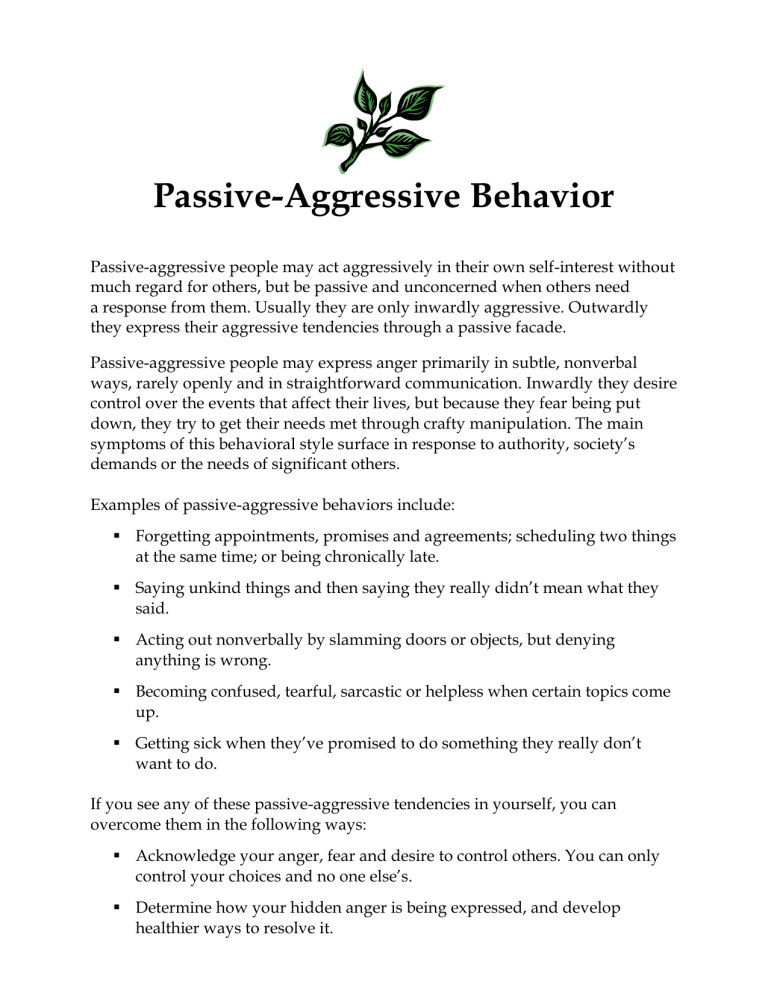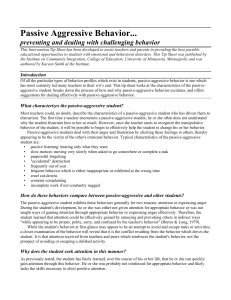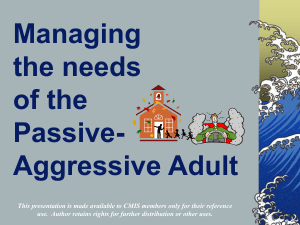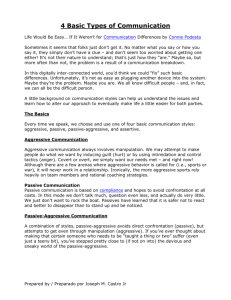Passive-Aggressive Behavior: Understanding & Overcoming It
advertisement

Passive-Aggressive Behavior Passive-aggressive people may act aggressively in their own self-interest without much regard for others, but be passive and unconcerned when others need a response from them. Usually they are only inwardly aggressive. Outwardly they express their aggressive tendencies through a passive facade. Passive-aggressive people may express anger primarily in subtle, nonverbal ways, rarely openly and in straightforward communication. Inwardly they desire control over the events that affect their lives, but because they fear being put down, they try to get their needs met through crafty manipulation. The main symptoms of this behavioral style surface in response to authority, society’s demands or the needs of significant others. Examples of passive-aggressive behaviors include: Forgetting appointments, promises and agreements; scheduling two things at the same time; or being chronically late. Saying unkind things and then saying they really didn’t mean what they said. Acting out nonverbally by slamming doors or objects, but denying anything is wrong. Becoming confused, tearful, sarcastic or helpless when certain topics come up. Getting sick when they’ve promised to do something they really don’t want to do. If you see any of these passive-aggressive tendencies in yourself, you can overcome them in the following ways: Acknowledge your anger, fear and desire to control others. You can only control your choices and no one else’s. Determine how your hidden anger is being expressed, and develop healthier ways to resolve it. Work on becoming independent and interdependent with others by developing a cooperative spirit. Take full responsibility for your own behavior, and learn how to make good choices for yourself. Refuse the easy way out of painful situations. Grieve your losses. Practice using willpower and self-discipline by being willing to delay gratification. Overcome selfishness by getting involved in the lives of others. Work on developing assertiveness skills such as: a. b. c. d. Using “I” rather than “you” to state feelings or problems; Being brief, clear and direct in making requests; Taking time to think through a request before you respond; and Learn to problem-solve. _______________________________________________________________________ The above information was taken from a passage written by By Dr. Sidney Langston References: Freedman, Alfred M., Kaplan, Harold I. & Sadock, Benjamin J. (1976). Modern synopsis of Comprehensive textbook of psychiatry/ II. Baltimore: The Williams & Wilkins Co. Malony, H. Newton. (1987). Speak up! Christian assertiveness. Flowertown, PA: Westminster Press. The passive-aggressive tendencies develop when children are reared by at least one controlling parent. This usually involves a domineering and controlling mother and an absent, weak or passive father. Such parents overprotect their children, make excessive demands on them, respond to them with mixed reactions of acceptance and hostility, and fail to meet their basic trust and dependency needs. All of this fosters a helpless and clinging attitude in children and inhibits the development of independence. Expecting other people to gratify their needs, the children grow up dependent on others to protect them and aid them in their daily responsibilities. They also tend to have low tolerance for frustration and stress. In such a situation, passive-aggressive behaviors develop as an expression of resentment against excessive parental demands. Children are not allowed to openly express hostility and they learn to vent anger and discouragement through more subtle means of rebellious behavior. They soon learn that negative behavior will at least get them attention. They may cause problems at school, violate rules and fight frequently with other students. By their teenage years they may lean toward an antisocial personality and be involved in drugs or delinquency. On the other hand, passive-aggressive people may assume a role of chronic submissiveness and compliance. They find it difficult to say “no,” and they dislike making major decisions. Feeling helpless, they look to others – usually to just one other person – to take responsibility for them. They learn to accomplish their goals through passive manipulation of others.





